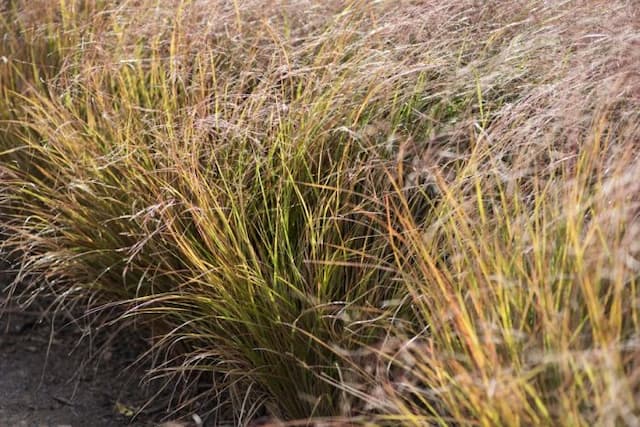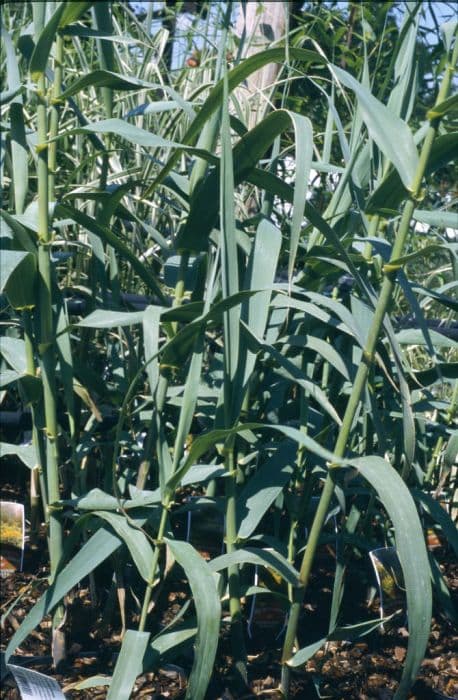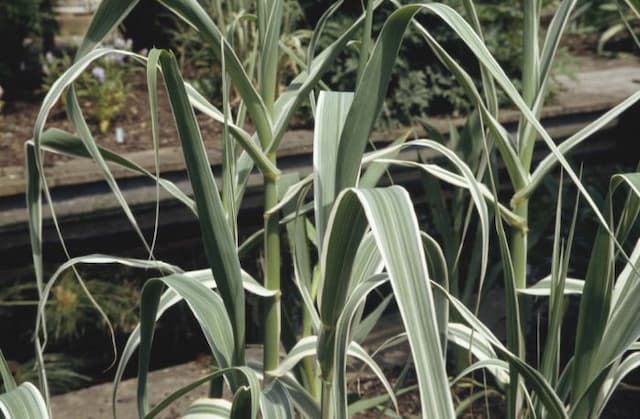Feather Reed Grass Calamagrostis × acutiflora 'Karl Foerster'

ABOUT
Commonly known as Feather Reed Grass, Calamagrostis × acutiflora 'Karl Foerster' is an ornamental grass that is valued for its tidy, upright growth habit and feathery inflorescences. The leaves of this plant are narrow, long, and have a bright green color, contributing to a lush, dense clump of foliage that serves as a great backdrop in garden settings. During the growing season, the foliage creates a strong vertical element with its upright and slightly arching shape. As the season progresses, Feather Reed Grass produces tall, slender stalks topped with elongated, wheat-like flower plumes. These inflorescences emerge with a purplish or pinkish tinge and gradually turn into a golden tan as they mature and move into the late summer and fall, catching the light and adding a soft, airy texture to the landscape. The contrast between the fine-textured flowers and the sturdy, green foliage adds visual interest and movement to gardens, especially when swaying in the breeze. The plant retains its structural form and visual appeal through the winter months, with the dried stalks and flower heads providing interest even under snow cover.
About this plant
 Names
NamesSynonyms
Feather Reed Grass, Karl Foerster Grass, Foerster's Feather Reed Grass.
Common names
Calamagrostis × acutiflora 'Karl Foerster'.
 Toxicity
ToxicityTo humans
Feather Reed Grass is generally considered non-toxic to humans. Therefore, there are usually no symptoms associated with poisoning because it is not known to be poisonous. However, individual allergic reactions or physical irritation from plant material could potentially occur for some individuals.
To pets
Feather Reed Grass is also considered non-toxic to pets. Much like in humans, there is no widespread report of toxicity in domestic animals such as cats and dogs, and it typically does not cause symptoms of poisoning if ingested. However, as with any plant, ingestion of large amounts could potentially cause gastrointestinal upset simply due to the ingestion of non-digestible matter.
 Characteristics
CharacteristicsLife cycle
Perennials
Foliage type
Deciduous
Color of leaves
Green
Flower color
Pink
Height
5 feet (1.5 meters)
Spread
2 feet (0.6 meters)
Plant type
Grass
Hardiness zones
5
Native area
Europe
Benefits
 General Benefits
General Benefits- Ornamental Value: Adds visual interest to landscapes with its tall, feathery plumes and upright growth habit.
- Low Maintenance: Requires minimal care once established, making it ideal for gardeners of all skill levels.
- Drought Tolerance: Can survive with limited water, making it suitable for xeriscaping and dry climate gardens.
- Year-Round Interest: Offers aesthetic appeal throughout the seasons with changing foliage and seed head colors.
- Wildlife Habitat: Provides shelter and food for birds and insects, supporting local biodiversity.
- Erosion Control: Its dense root system stabilizes soil and prevents erosion on slopes or banks.
- Versatility: Fits well in a variety of garden designs, from formal to naturalistic settings.
- Privacy Screening: When planted in groups, it can create an effective visual screen or windbreak.
- Cold Hardiness: Capable of withstanding low temperatures, suitable for gardens in colder regions.
- Companion Planting: Pairs well with a wide range of perennials and grasses, enhancing garden design.
 Medical Properties
Medical PropertiesThis plant is not used for medical purposes.
 Air-purifying Qualities
Air-purifying QualitiesThis plant is not specifically known for air purifying qualities.
 Other Uses
Other Uses- Feather Reed Grass can be used as an effective sound barrier when planted in thick rows, helping to reduce noise pollution in a garden or yard.
- Its dense growth habit and tall structure can provide privacy screening for outdoor spaces, creating a natural and aesthetically pleasing barrier.
- The dried inflorescences of Feather Reed Grass can be harvested and used as a natural stuffing material for homemade dolls or cushions.
- Feather Reed Grass can be incorporated into wildlife gardens as a shelter for small animals and beneficial insects.
- It can be used in creating woven crafts such as baskets or mats when the stems are dried and treated for flexibility.
- Feather Reed Grass is sometimes utilized in floral arrangements or as a part of dried flower displays due to its attractive seed heads.
- Its sturdy stems can be used as natural stakes or supports for other plants in the garden that may need assistance standing upright.
- Feather Reed Grass can be planted on slopes or banks for erosion control, as its root system helps to hold the soil in place.
- The plant is used in theme gardens, like contemporary or prairie-style gardens, to add vertical interest and texture.
- Creative gardeners may use the tall, linear form of Feather Reed Grass to create outdoor garden rooms or defined pathways.
Interesting Facts
 Feng Shui
Feng ShuiFeather Reed Grass is not used in Feng Shui practice.
 Zodiac Sign Compitability
Zodiac Sign CompitabilityFeather Reed Grass is not used in astrology practice.
 Plant Symbolism
Plant Symbolism- Resilience: Calamagrostis × acutiflora 'Karl Foerster', commonly known as Feather Reed Grass, is a robust and hardy plant that can withstand various challenging conditions, symbolizing the ability to endure and persist through difficulties.
- Elegance: With its tall, slender form and feathery plumes that sway gracefully in the breeze, Feather Reed Grass represents elegance and gracefulness.
- Privacy: Often used in landscaping to create natural screens or borders, Feather Reed Grass can symbolize the need for personal space and privacy.
- Adaptability: Feather Reed Grass is known for its adaptability to a range of environments, from wet to dry conditions, symbolizing the flexibility and adaptability in life.
- Growth: The vertical growth habit of Feather Reed Grass symbolizes upward movement and progress, reflecting personal growth and development.
 Water
WaterFeather Reed Grass should be watered deeply once a week, ensuring that the soil is moist but not waterlogged. During hot or dry spells, you might need to water twice per week. Each watering session should provide about 1 to 1.5 inches of water, which translates to roughly 0.62 gallons per square foot of soil area. Ensure the water penetrates the soil to reach the roots. Overhead watering in the early morning is best to allow foliage to dry out during the day, reducing the risk of fungal diseases.
 Light
LightFeather Reed Grass thrives in full sun conditions, requiring at least six hours of direct sunlight daily. However, it can also tolerate light shade but may not grow as upright and may flower less prolifically. The ideal spot for this plant is an open area where it receives unfiltered sunlight for the majority of the day.
 Temperature
TemperatureFeather Reed Grass is cold-hardy and can survive winter temperatures as low as -20 to -30°F, making it suitable for growing in USDA zones 4 through 9. The ideal growing temperature range for this grass is between 60 and 75°F, but it can also tolerate higher summer temperatures without issue. Extreme heat may slow its growth temporarily.
 Pruning
PruningFeather Reed Grass should be cut back to about 3 to 6 inches from the ground in early spring before new growth starts. Pruning is necessary to remove old foliage and make way for new shoots. It's usually done annually, and the best time for pruning is when the threat of hard frost has passed but before new growth begins.
 Cleaning
CleaningAs needed
 Soil
SoilThe best soil mix for Karl Foerster, also known as Feather Reed Grass, should be well-draining yet retain some moisture, such as a mix of loam, sand, and compost. The soil pH should be mildly acidic to neutral, ranging from 5.8 to 7.2, which will support healthy growth and ensure good nutrient availability.
 Repotting
RepottingFeather Reed Grass (Karl Foerster) is generally grown outdoors and does not require repotting as it is not typically container-grown. Instead, it may be divided every few years in the spring to manage its size and rejuvenate the plant.
 Humidity & Misting
Humidity & MistingFeather Reed Grass (Karl Foerster) is quite tolerant of a range of humidity conditions and will thrive outdoors in the ambient humidity available in most temperate climates. No specific humidity level is required.
 Suitable locations
Suitable locationsIndoor
Feather Reed Grass, not ideal for indoor growth; requires full sun.
Outdoor
Plant Karl Foerster in full sun, well-drained soil; tolerates different conditions.
Hardiness zone
5-9 USDA
 Life cycle
Life cycle'Karl Foerster' Feather Reed Grass, as a perennial plant, starts its life cycle with germination from seed, though it is often propagated through division. Once established, the grass emerges in early spring, quickly forming dense, upright clumps of foliage. By early to mid-summer, it sends up tall, slender stems that bear feathery, wheat-colored panicles, which are highly valued for their aesthetic appeal. The inflorescences remain attractive through fall and into winter, providing structure and interest in the landscape even as the plant goes dormant. During the cold season, the foliage and seed heads turn a golden tan and persist, offering visual interest and habitat for wildlife. In early spring, the old growth is typically cut back to the ground to make way for fresh growth, thus completing the cycle and starting anew.
 Propogation
PropogationPropogation time
Spring
Calamagrostis × acutiflora 'Karl Foerster', commonly known as Feather Reed Grass, should ideally be propagated in the spring or early summer to allow sufficient time for root establishment before the onset of winter. The most popular method of propagation for Feather Reed Grass is division. To divide, dig up an established clump and gently separate it into smaller sections, each with a portion of the root system and several shoots. Replant these divisions immediately at the same depth they were previously growing, spacing them about 18 to 24 inches (approximately 45 to 60 centimeters) apart to allow enough room for growth. Water the new plantings thoroughly to help establish the roots. This grass tolerates a wide range of soil types but thrives in well-draining soil with consistent moisture. Division not only helps to propagate new plants but also rejuvenates older clumps that may have become woody or less vigorous in the center.









